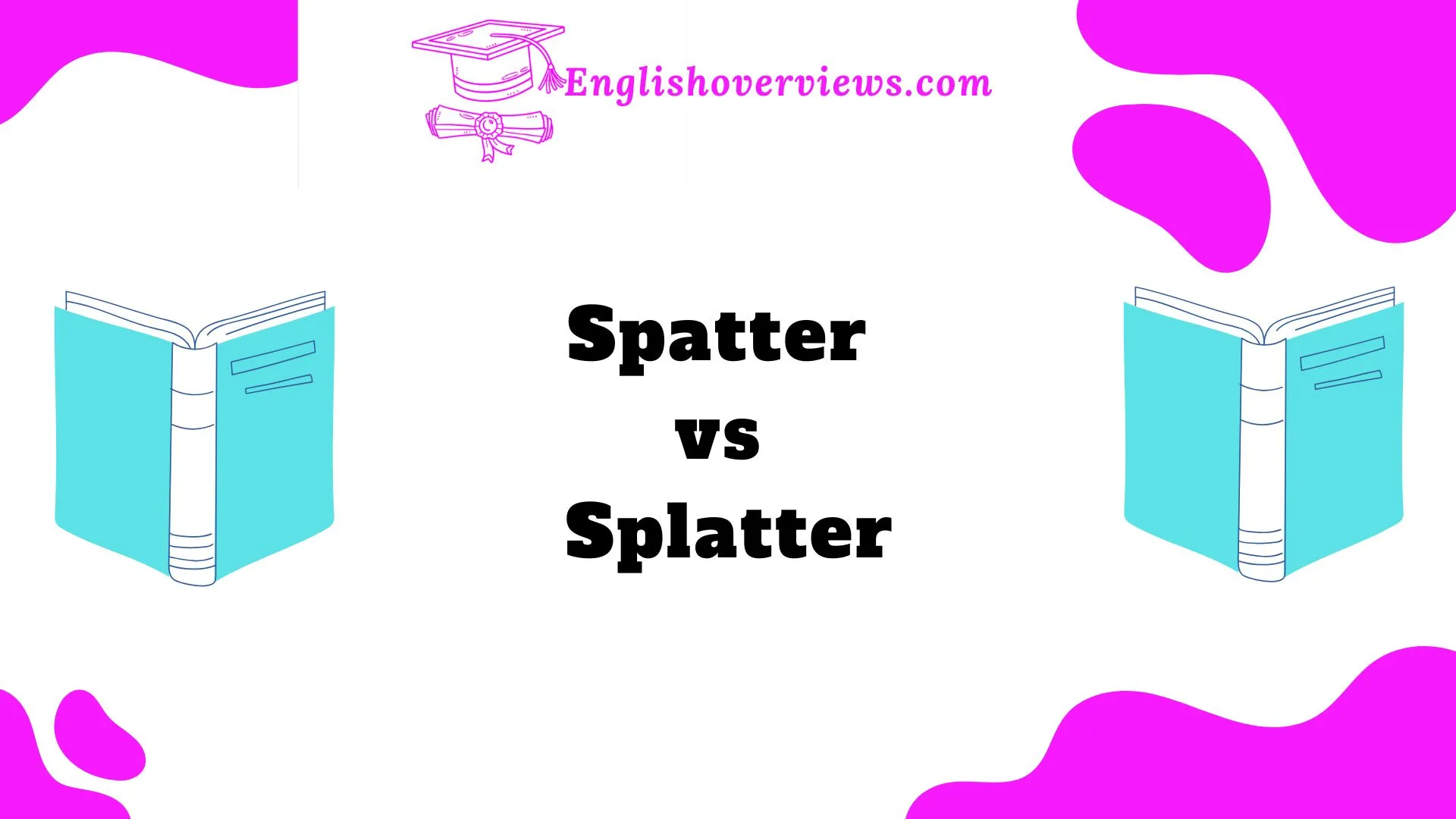When we think of the words spatter and splatter, both evoke imagery of something being spread around in a messy way. But do you know the difference between them? Many people use these terms interchangeably, but they have distinct meanings and uses.
In this blog post, we’ll explore the nuances between spatter and splatter, breaking down their definitions, historical roots, and practical applications.
We’ll also look at when it’s important to use one over the other in writing and in real-life contexts like crime scene analysis. Let’s dive in and clear up the confusion once and for all!
Deciphering the Definitions: Spatter vs. Splatter
What is Spatter?
At its core, spatter refers to small particles or drops scattered or thrown with light force. The spread of these particles is usually uneven but not chaotic. Think of paint splashing lightly from a brush or drops of water landing on a surface after being disturbed by a light touch. The key idea here is that spatter occurs with minimal force and typically creates a smaller, more controlled distribution.
Examples of spatter:
- Spatter of oil in the kitchen.
- Blood spatter in forensics, where small drops land in a specific pattern due to minor impact.
- A light paint spatter while dabbing a brush on canvas.
What is Splatter?
On the other hand, splatter involves a more forceful action, where larger droplets or messy dispersions are created, typically as a result of an impactful or explosive action. When you think of splatter, think of something like a water balloon bursting or food flying out of a pan while frying. It is much more chaotic and widespread.
Examples of splatter:
- Splatter of sauce while stirring a pot.
- Food splatter from a pan of hot oil.
- Blood splatter at a crime scene resulting from a violent impact.
Quick Comparison:
| Feature | Spatter | Splatter |
| Force | Minimal force | Strong impact |
| Size of Drops | Smaller, finer drops | Larger, messy drops |
| Visual Effect | Evenly spread | Chaotic, scattered across surface |
| Common Contexts | Art, light accidents, forensics | Cooking, violent accidents, media |
Origins and Evolution of ‘Spatter’ and ‘Splatter’ in Language
The Origins of ‘Spatter’
The word spatter has been around for centuries. Its roots can be traced back to the Middle English word “spateren,” which meant “to scatter.” Over time, it evolved into the form we use today. Historically, spatter was associated with anything lightly splashed or scattered—whether it was dirt, liquid, or paint.
Its usage became more common in the art world, where spattering was a method used by painters like Jackson Pollock to create textured, dynamic works of art.
The Development of ‘Splatter’
Meanwhile, splatter emerged later, becoming popular in the 20th century as a more dramatic, high-energy term. The first recorded use of the word was in 1934, and it quickly became associated with chaotic, forceful actions.
In the visual arts, it was often used to describe the energetic, sometimes violent splashes of paint seen in abstract expressionism. In popular culture, the word splatter also gained traction in movies, especially in horror and action genres, where blood and guts were often splattered around during intense scenes.
The Historical Roots of ‘Spatter’
In early texts, spatter was primarily used to describe the dispersal of liquids or small particles. It had a practical application in medicine, agriculture, and the arts. For example, spatter was used in the medical field to describe blood droplets caused by minor wounds or injuries.
One early use of the term appeared in Shakespeare’s plays, where it was employed to describe minor splashes of blood or other liquids in battle scenes. The word had a less chaotic, more controlled connotation in those days.
The Blended Birth of ‘Splatter’
Splatter, however, carried a different tone. As mentioned earlier, it emerged primarily during the 20th century and grew in popularity during the Abstract Expressionism movement. It was used to describe the forceful application of paint or the result of violent action.
Over time, it was embraced in film, particularly in the slasher horror genre, where the word vividly described the gruesome, chaotic scenes of blood and gore.
Literary Examples and Usage in English
Spatter in Creative Writing
Authors use spatter to convey subtlety, often describing minor, almost incidental splashes. In literature, it’s used when the splash is a small, fleeting occurrence. Take for example Ernest Hemingway, whose descriptions of blood spatter in his war novels are not overly dramatic but rather suggest the impact of violence without detailing every drop.
Example from Hemingway’s A Farewell to Arms:
“Blood spattered across the floor, and the soldiers took cover.”
This example demonstrates the subtlety of spatter—it’s there, but the focus remains on the action and environment.
Splatter in Creative Writing
On the other hand, splatter is used in thrillers and horror fiction to emphasize violent, messy action. It creates a more visceral, chaotic image that grabs the reader’s attention.
Example from Stephen King’s It:
“The red liquid splattered across the room, pooling around their feet.”
Here, splatter creates an immediate sense of panic and mess, reinforcing the chaotic atmosphere of the scene.
Visualizing the Variance: Spatter and Splatter in Imagery
Let’s now look at a more visual comparison:
- Spatter: Imagine a light flick of a brush, where small droplets of paint are carefully placed to create a texture.
- Splatter: Picture a bucket of paint being tipped over, spilling all over the floor.
Spatter in Art
Spattering can be controlled in abstract art, where artists deliberately spread small drops of paint. A well-known example is Jackson Pollock’s paintings, where controlled spattering created a sense of movement.
Splatter in Art
In contrast, splatter in art can also be chaotic, evoking force and randomness. The action painting style was popularized by artists like Willem de Kooning, whose works sometimes incorporated violent splattering of paint.
Practical Applications: When to Use ‘Spatter’ Over ‘Splatter’
Now, when should you use spatter instead of splatter?
Spatter
Use spatter when describing light, controlled dispersions of liquid, or when the action is more subtle. For instance:
- Spatter in bloodstain pattern analysis is used when blood droplets are small and dispersed with little force, indicating a less violent crime scene.
Splatter
Use splatter when the dispersion is more dramatic and forceful, like the explosion of food in a pan or the chaotic spread of blood in a violent crime scene. Examples include:
- Food splattering when frying.
- Blood splatter in crime scene investigations.
Example Uses:
- Spatter: “The spatter of raindrops on the windshield made it hard to see clearly.”
- Splatter: “The paint splattered across the canvas in wild strokes.”
Contextual Clues in Creative Works
Contextual Usage in Writing
When deciding whether to use spatter or splatter, context is everything. Look for clues in the text:
- Spatter is likely the right choice when the splash is subtle and controlled.
- Splatter is more appropriate when the splash is dramatic and chaotic.
In creative works, both can be used to evoke different moods. For instance, splatter in a horror movie makes an intense scene feel even more visceral.
The Significance in Forensics and Crime Scene Analysis
In the world of forensics, the difference between spatter and splatter is crucial, especially when analyzing bloodstains at crime scenes.
Blood Spatter vs. Blood Splatter
- Spatter refers to smaller drops that result from a light impact, often seen in low-velocity impacts.
- Splatter refers to larger, more forceful patterns, typically seen in high-velocity impacts, such as gunshots or blunt force trauma.
Understanding these distinctions helps forensic experts determine the nature of a crime and the sequence of events.
Common Misconceptions and Interchangeable Usage in Everyday Communication
Many people often use spatter and splatter interchangeably, but this can create confusion, especially in technical contexts like forensics or writing.
For instance, describing blood splatter at a crime scene may be misleading if the spatter was minor. Using the right term helps convey more precise information.
Conclusion: Mastering the Distinction
To sum it up, while both spatter and splatter describe the scattering of liquid or particles, they differ significantly in terms of force, size, and visual impact. Understanding these differences can help you make your writing and communication more precise, whether you’re describing a gentle splash of paint or a violent scene in a thriller.
Quick Tips:
- Use spatter for smaller, less dramatic dispersions.
- Use splatter for forceful, chaotic, or larger dispersions.
- Pay attention to context, especially in creative writing, forensics, and everyday communication.
FAQs
1. Can I use ‘spatter’ and ‘splatter’ interchangeably?
No, it’s important to use them correctly based on the context. Spatter refers to light, controlled dispersion, while splatter refers to forceful, messy spreads.
2. Is ‘splatter’ used more in artistic contexts?
Yes, splatter has been used more in Abstract Expressionism and action art, where the term captures the chaotic, energetic nature of the art.
3. What’s the difference between blood spatter and blood splatter?
Blood spatter refers to small, controlled droplets, while blood splatter involves large, forceful drops typically seen in violent events.
4. How can I remember the difference?
Think of spatter as subtle and controlled, like light rain or paint flicking from a brush. Think of splatter as wild, chaotic, and forceful, like food exploding in a frying pan.

English Overviews is a resourceful website dedicated to providing valuable content related to grammar and vocabulary. Muhammad Haroon has made notable contributions, sharing insights on various subjects, including WordPress themes and plugins. The primary goal of the site is to help users improve their English language skills effectively.











